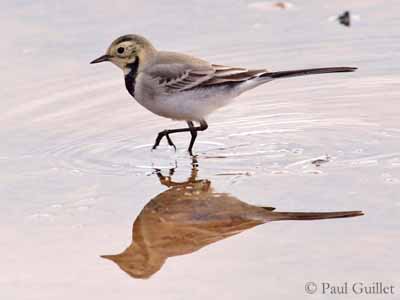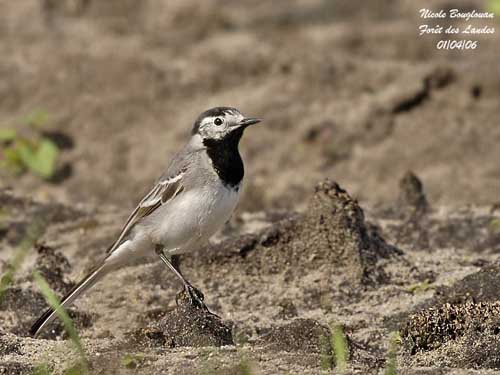
Fr: Bergeronnette grise
All : Bachstelze
Esp : Lavandera Blanca
Ital: Ballerina bianca
Nd: Witte Kwikstaart
Sd: Sädesärla
Photographers:
Paul Guillet
Photos d’Oiseaux
Nicole Bouglouan
PHOTOGRAPHIC RAMBLE
Text by Nicole Bouglouan
Sources:
HANDBOOK OF THE BIRDS OF THE WORLD Vol 9 - by Josep del Hoyo - Andrew Elliot - David Christie - Lynx Edicions - ISBN: 8487334695
THE HANDBOOK OF BIRD IDENTIFICATION FOR EUROPE AND THE WESTERN PALEARCTIC by Mark Beaman, Steve Madge - C.Helm - ISBN: 0713639601
L’ENCYCLOPEDIE MONDIALE DES OISEAUX - Dr Christopher M. Perrins - BORDAS - ISBN: 2040185607
ENCYCLOPEDIE DES OISEAUX DE FRANCE ET D’EUROPE – de Peter Hayman et Rob Hume - Flammarion – ISBN : 2082009920
Avibase (Lepage Denis)
BirdLife International (BirdLife International)
Pájaros de España (JL Beamonte)
What Bird-The ultimate Bird Guide (Mitchell Waite)
Wikipedia, the free encyclopaedia
White Wagtail
Motacilla alba
Passeriforme Order – Motacillidae Family
BIOMETRICS:
Length: 16,5 – 18 cm
Wingspan: 25 cm
Weight: M: 20 - 24,5 g – F: 17,5 – 22 g
DESCRIPTION:
The White Wagtail is mostly an aquatic bird, but this species can be common in various types of habitats, as well near water to hunt as in urban parks and cities for roosting in trees.

The adult male of nominate race in breeding plumage has black and white head. The forehead, lores, cheeks, ear-coverts and head sides are white. Chin and throat are black, as the rear crown, the nape and the hind neck.
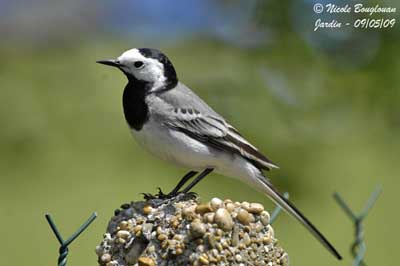
On the upperparts, mantle and scapulars to uppertail-coverts are grey. The upperwing shows greyish, black and white pattern, forming two white wingbars.
The long tail shows black central pair of rectrices finely edged white. The outer two pairs are white. The tail is similar in length to the wings.
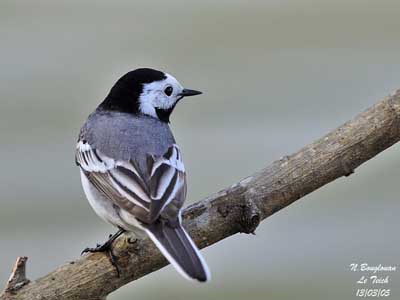
On the underparts, following chin and throat, breast is black too and contrasts strongly with the white belly. Breast sides and flanks are washed pale grey.
The pointed bill is black. The eyes are blackish-brown. Legs and feet are black.
The female in breeding plumage has slightly duller head pattern, with sometimes some grey on crown and nape. There often are some pale spots on the black throat.
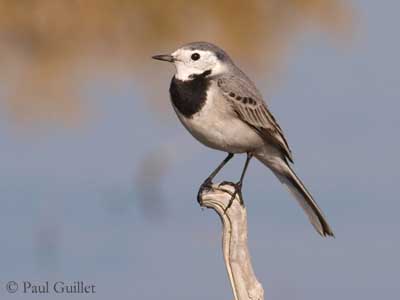
In non-breeding plumage, both sexes have olive-grey wash on both crown and nape. Chin, throat and breast are white with some black mottling.
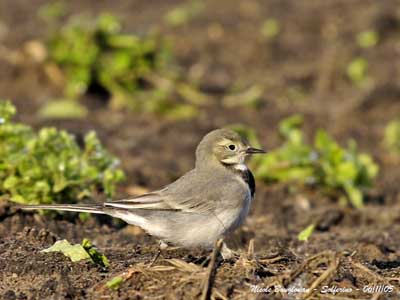
Immature has brownish-grey head with dusky malar stripe. Chin and throat are greyish-white with narrow grey-brown gorget. The underparts are greyish-white with buff tinge.
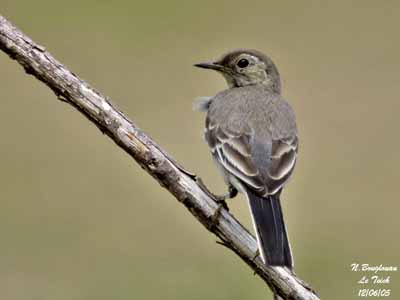
There are several subspecies which differ in colour of upperparts and in head pattern. Some of them are now full species.
VOICE: SOUNDS BY XENO-CANTO
The White Wagtail in flight utters a high-pitched “tslee-wee” or “tslee-vit” often repeated and some variants. We can also hear a short “tsit”, a harsh “chizzick” and a more slurred “tzwerp”.
The song is a series of twittering phrases interspersed with call notes.
At roost, they utter twittering noises.
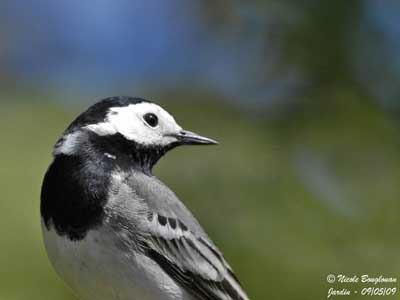
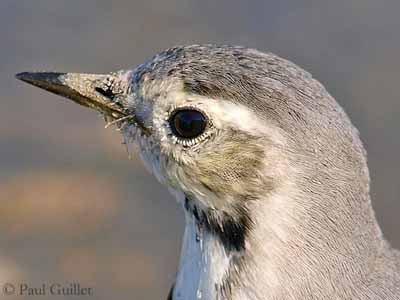
HABITAT:
The White Wagtail frequents a wide variety of open wet and dry habitats such as seashores, upland rivers and slow-moving lowland rivers, and lakeshores. But this species is also found in cultivated areas, urban parks and gardens, and in the vicinity of towns and cities. This bird is common in gardens around human habitations.
During migrations or winter, it also frequents various wet areas such as edges of reservoirs, lakes and ponds, ricefields and irrigated fields, towns and cities, campsites and beaches.
This species can breed from lowlands to high mountains (up to 5000 metres of elevation in the Himalayas).

RANGE:
The White Wagtail breeds in most parts of Europe and Asia, and some regions of North Africa.
BEHAVIOUR:
The White Wagtail feeds on numerous small aquatic and terrestrial invertebrates. It catches insects on the ground after a short pursuit, but also on the wing. It pursues the prey with rapid undulating flight, or by short hovering before to hawk it. On the ground, this bird hunts by walking and exploiting all types of surfaces, from roads to roofs and other open areas.
It can pick at preys by running and picking to capture them. It also jumps into the air to hawk a flying insect.
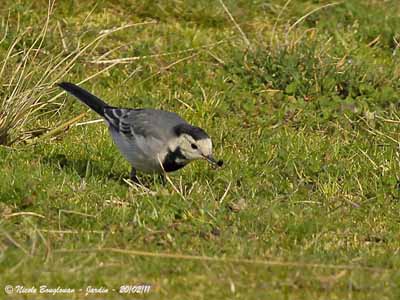
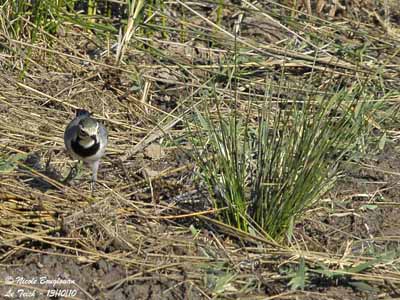
But this aquatic species also forages in shallow water where it catches invertebrates from the surface or in the mud. It also hovers over water or vegetation.
On seacoasts, it forages among the seaweeds along the tideline. When foraging in cultivated areas, it follows the ploughs.
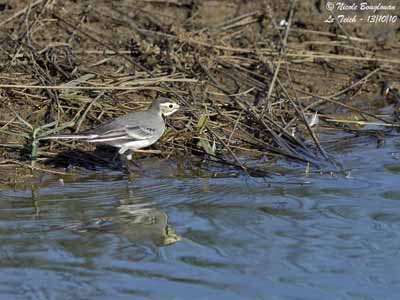
The White Wagtail can be seen alone or in pairs, but during the migration, the birds often gather in loose flocks, as at abundant food sources and at roost.
They roost communally in trees or reedbeds, sometimes inside factories in urban areas.
During the breeding season, the White Wagtail is very territorial and can become very aggressive towards other birds and intruders. They can chase larger birds such as Dippers and shorebirds from the breeding territory. During these threat displays, the plumage is usually puffed up and the tail is raised. The black breast is exposed towards the intruder.
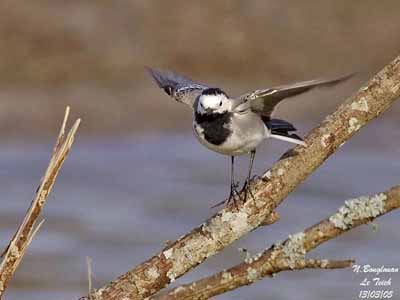
Aerial displays are observed with the male flying into the air and then descending with vibrating raised tail and wings, while singing.
When the male arrives in the territory, the female performs greeting displays with head and tail raised at an angle of 45 degrees. She also adopts a cringing posture and quivers her wings.
During the breeding cycle, other displays occur when the adults take turns to incubate, and the male performs courtship feeding to the female, including during the nesting period when she is on the nest.
The White Wagtail can be resident or migratory according to the range.
Usually, the northernmost populations migrate southwards to winter in Africa (in the arid northern part bordering the Sahara) or in southern Asia (in Arabia and across the southern parts of Asia, from Indian subcontinent to SE China). The races living in mountains mainly perform altitudinal movements.
FLIGHT:
The White Wagtail has strongly undulating flight, performed with several shallow, quick wing-beats.
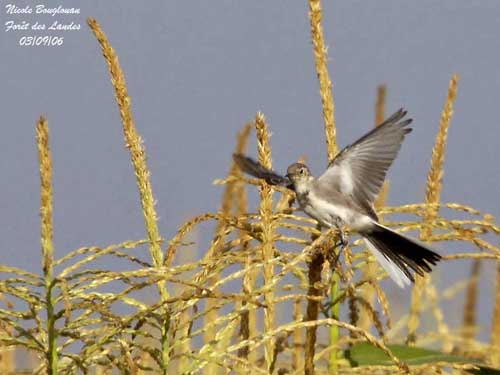
REPRODUCTION:
The breeding season occurs between April and August according to the range. This species can produce three clutches per year.
The nest is built by both sexes in hole or in crevice in the riverbank, or in wall or bridge, and also in buildings. That is a rough cup made with twigs, stems of grasses, leaves, rootlets and moss. The interior is lined with soft materials such as feathers, wool or hair.
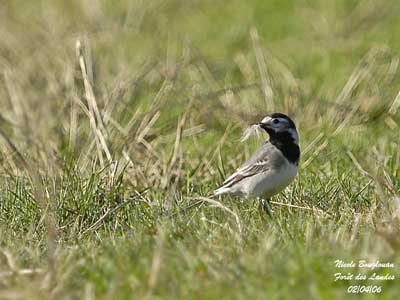
The female lays 3-8 whitish eggs with some small dark markings. The incubation lasts 12-15 days, shared by both parents but mainly by the female and especially at night. At hatching, the chicks are covered in grey down. They are fed by both adults during about two weeks, and they depend on them for one week more after fledging.

DIET:
The White Wagtail feeds on wide range of aquatic and terrestrial invertebrates, from coleopterans, damselflies, dipterans (adults and larvae), isopterans and hymenopterans, to spiders, small snails, crustaceans and worms. It also takes household scraps.
It forages by walking on the ground, or jumping into the air to hawk flying insects, or by wading in shallow water and mud.
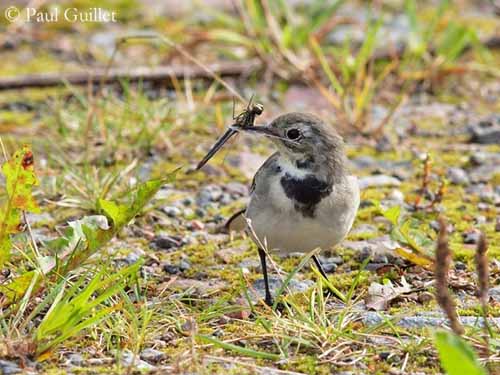
PROTECTION / THREATS / STATUS:
The White Wagtail is usually common throughout the range. In some regions, is can be very common or abundant.
The populations are stable, except after hard winters which involve some declines.
Currently, this species in not threatened, due to its adaptability to various types of habitats including close to human settlements where it can take household scraps.
